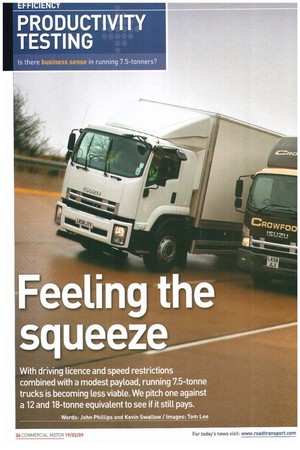FeeLing the squeeze
Page 34

Page 36

If you've noticed an error in this article please click here to report it so we can fix it.
With driving licence and speed restrictions combined with a modest payload, running 7.5-tonne trucks is becoming less viable. We pitch one against a 12 and 18-tonne equivalent to see if it still pays.
Words: John Phillips and Kevin Swatlow / Images: Tom Lee Productivity can be measured by the effectiveness of your workforce or the effectiveness of your trucks. To achieve maximum productivity you need to pitch expenditure against income. The latter should be consistent, verging on the upwardly mobile, and you should allow for standing and running costs. reinvestment and a 20% profit margin.
How close operators can get to that business model, as recommended in the National CPC Licence literature, is open to debate. So what is there to consider? Purchase price, depreciation, insurance, VED rates, wages, fuel costs, payload and vehicle utilisation are just some of the factors.
When it comes to specifying vehicles, fleet operators tend to stick with what they know. But times are changing and practices set out by previous generations might not be as productive today as they were. With increasing weight categories, licensing laws, speed restrictions and potential payload, the boundaries of efficiency continue to shift.
Whether two small vans are cheaper to run than one 7.5-tonne truck is debatable as it requires two drivers, two wages, and two sets of standing and running costs to make up the payload weight. Frequent, time-sensitive delivery schedules might swing it — and, of course, the use of small vans bypasses speed and licensing issues.
The trend is always up the weight table and speed issues have created a level playing field for all two-axle chassis-cabs requiring an 0-licence.
An increasingly important factor is that anyone who passed their car driving test after 1 October 1997 cannot drive a 7.5-tonne truck on their car licence. However, 7.5-tonne work is traditionally multi-drop and requires an A The move away from energetic approach; as such, it isn't always suited to older 7.5 tonnes Ifar righti workers who enjoy grandfather rights to 7.5-tonners.
is stilt open to debate Therefore operators have to pay a younger HGV Cat C qualified driver who can drive much heavier vehicles.
It all sounds negative for the 7.5-tonne truck, but it has far from had its day. Volume-conscious operators, home delivery services, local authorities and own-account operators still all swear by it.
Restricted drivers
The market developed after 1978 when licensing laws restricted drivers on a car licence to driving vehicles with a maximum GVW of 7.5 tonnes, down from 10 tonnes, before a heavy goods licence was required. In 1989, the market peaked at more than 19,000 units. Since 1998, sales of 7.5-tonners have fallen from more than 15,500 units to 9,670 last year. The 7.5 to 12-tonne market has enjoyed growth to more than 1,300 units from 1,150 in 2007, whereas the 12 to 15-tonne market has slipped to 1,390 units, down 290 against 2004 figures And, apart from a blip for digital tachographs, the 18-tonne market has remained fairly consistent at 7,000-8,000 units a year.
While the 7.5-tonne sector has dwindled, operators moving up the weight chain to 18 tonnes replace those who are moving out of that category towards heavier vehicles at 26 tonnes. •
















































































































































